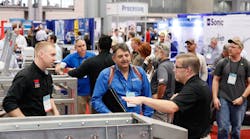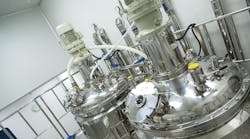Heat-transfer equipment, such as steam condensers running in power plants or heat exchangers operating in chemical refineries, needs proper attention and maintenance. Through decades of trial and error, engineers around the world have worked to develop cutting-edge solutions that address common problems with equipment that uses water as a source to change the temperature of the surrounding machinery or atmosphere. Heat exchangers represent a large part of the fixed equipment operations of refineries, power plants, steam-powered ships, buildings, and plants across many industries. When operating reliably they have a significant impact on plant efficiency.
Corrosion and fouling are par for the course in an environment of water, oxygen, suspended solids and biological materials running against metal. In using tubular heat exchangers, equipment requires specialized treatment in order to continue to run effectively, efficiently, and optimally. Corrosion protection through the use of sophisticated chemical coatings applied to the inner and outer diameters of the tubular is a breakthrough technology that has seen vast improvement in recent decades.
Engineers at a German chemical company first developed phenolic materials for tube ID coatings in the 1950s. A group formed a company (Saekaphen, GmbH) to promote this material application commercially. Using a fill, drain, and rotate method in a specialized shop, this was generally acknowledged as the industry’s best option to fully coat the ID of small diameter tubes in heat exchangers. About 30 years later, innovators began to employ air-atomized spray application methods to coat tubular IDs. Materials were also evolving, and the use of ambient cured epoxy-phenolics offered excellent results and improved fouling- and corrosion-resistance to the main condensers, actually restoring the units to their normal operating capacity. In the following years, more equipment development led to a proven application for in-field coating applications of new or used exchanger tubes.
Through this evolution in technology, companies have been able to save millions of dollars in maintenance and related costs each year. For example, one West Coast refinery recently estimated that by coating the tube IDs in its heat exchangers, it saved $30,000 per day in reliable production, reduced downtime, and lower energy costs — amounting to nearly $9 million per year. Other refineries using heat exchangers with tube ID coating have recognized significant O&M savings. For
example, a Gulf Coast refinery employed tube ID coatings and saved an estimated $2 million annually from a reduction in maintenance projects. In fact, cleaning cycles were extended up to three times compared to past maintenance records.
Polymer Power: The New ‘Flower Power’?
To maintain optimal performance of low-cost carbon steel tubes, cooling water flowrates, pH levels, and temperature must be maintained through an operat-
ing unit that may have many pieces of equipment tied to the same loop.
Carbon steel is the lowest-cost metal available for exchanger tubing, representing as much as one-quarter of the cost of comparable nickel and
chrome/moly alloy materials, including admiralty brass, 70/30, or duplex stainless steel. The inherent passivation of these high-alloy materials in cooling
water provides advantages when compared to the oxidation of carbon steel.
Many refineries and chemical plants opt to use an alloy upgrade as a replacement for carbon steel exchangers when aggressive fouling and corrosion impacts production units. However, the benefits of tube ID coating certainly qualifies it as a lower-cost option than alloy upgrades for many carbon-steel exchangers in cooling-water service.
Polymer linings, such as high-baked phenolics, phenol epoxy, and novolacs epoxy, are commonly used in environments, such as tankage, transport containers, and vessels. In ambient temperature conditions, these linings provide resistance to a range inorganic and organic acids, solvents, and hydrocarbons. Most applications call for coating films to be applied at thicknesses typically greater than 20 mils, and materials are often loaded with glass or ceramic pigments to inhibit porosity over time.
Selecting a lining material for thin-film applications suitable for cooling water service requires a material to provide the following mechanical characteristics:
• Homogenous coverage at films less than 10 mils;
• Adhesion resistance >2,500 PSI;
• Resistance to thermal cycling and conditions exceeding operating temperatures; and
• Superior release of foulant such as cal-
cium and sulphite deposits.
The chemical- and heat-resistance properties of these linings are improved through a heat cure of the application — up to 300 F for baked phenolics and to
250 F for epoxy applications.
Cooling water corrosion makes metallic tubes susceptible to fouling and bacterial contamination that eats away at inner and outer surfaces. Leaks and damage, pitting, and obstructive buildup all require frequent stoppages for maintenance and cleaning. With bare, uncoated tubes, stoppages for repair and cleanings may occur up to five times more often than with coated tubulars. Bare tubes are also subject to erosion, diminishing their useful life and often leading to the need for entirely retubing the heat-transfer equipment as it ages. This is a costly recourse, and one that can largely be avoided with the appropriate application of coatings.
In chemical processing plants, good maintenance practices (GMP) yield better asset utilization and business results. The cost of entirely retubing a large piece of heat-transfer equipment can climb into the tens or hundreds of thousands of dollars. Over time, engineers have hit on a much more cost-efficient way to extend the life of tubes. By applying coatings of phenolic or epoxy compounds designed for maximum protective effect for each base metal tubular system, the productive life of heat-exchanger equipment is enhanced into perpetuity.
As earlier noted, it is now possible to apply coated linings to equipment on site or in-situ, which reduces downtime, expense, and the inconvenience of transporting large heat-exchanger equipment to a remote shop.
Coating vs. Retubing &
Other Options
Cooling water treatment is a large discipline and valuable resources are dedicated to maintain and tune the cooling water systems at industrial complexes. Water-borne minerals, solids, and microbes, along with heat and changes in water flow, create an opportunity for fouling and scale attachment. Microorganisms that draw nutrients from cooling water inside tubes can cause bacterial buildup and fouling. These common mechanisms leading to corrosion cells are created inside condenser and heat exchanger tubes, as bacteria breed quickly in these nutrient-rich environments, which are enhanced by certain chemical processes and the lack of light inside the tubes. Also, oxygen in water creates aggressive deposits called tuberculation; generally wall loss is aggressive under the large tubercles that attach to tube walls.
Each corrosion cell creates a pit — a place for bacteria to further multiply and hide — which leads to intricate bacterial structures that rapidly advance corrosion and produce inefficient and even dangerous blockages. Further, such bacterial pits can cause electrochemical changes inside tubes that exacerbate the damage. Another common cause for tube pitting and corrosion is activated films, which can galvanize inside the tube from sulfide or manganese influences. If these potentials differ from the base metal, the reaction can cause pitting, inviting severe biologic decay and faster deterioration of the tubing.
Generally, tube pitting can be corrected in several ways: cleaning, chemical treatment, and retubing. But none of these options is as viable or cost-effective as coatings.
Cleaning: Because of the bacterial component of pitting, removal of tube deposits and adoption of better methods for tube cleaning can halt deterioration, or at least stabilize the rate. Deep pits can be identified through eddy testing and preventatively plugged prior to cleaning. Rough cleaning can be accomplished by brushes and scrapers, or by using hydrolyzing or sponge balls. Tubes need to be decontaminated as well. Low chloride potable water that has been demineralized, or water conditioned with a chloride neutralizer, can flush out contaminating chlorides. Finally, abrasive blasting can be used to remove the last vestiges of tube contamination.
Chemical Treatment: Biocides or oxidizing agents can be used on the tubes to control biological activity. Biostats can be used after a biocide treatment to control future growth, a milder form of chemical control. In recent years, chemical treatment has fallen out of favor due to the toxic nature of the chemicals used.
Retubing: If severe pitting cannot be alleviated, complete retubing of the heat exchanger may be called for, particularly in older equipment that has run for consecutive years. Choosing a more appropriate tube material or accelerating maintenance can stave off recurring fouling and corrosive conditions; however, this option is extremely costly and may have to be done several times to prolong the working life of the apparatus. The bare tube surfaces will inevitably sustain pitting and bacterial buildup as long as they remain uncoated.
Traditionally, water treatment and periodic cleaning by hydroblasting managed the tubular cleaning process, but the results were not always optimal. Over the years, this practice has evolved and matured into a cost-effective remedy to reduce typical fouling and corrosion. Improvements in materials, surface preparation, application techniques, and thermal conductivity, plus owner-operator data collection and analysis, have established tubular coatings as viable heat-transfer equipment solutions.
Today, ID coatings are considered the most cost effective practice for extending the performance and lifecycle of a heat-transfer system. It took decades of trial and error to find the right solutions for each ID, bare metal, and chemical coating compound to optimize the practice for each and every application.
Do Coatings Affect Heat Transfer Properties?
Despite some sentiment to the contrary, coatings actually improve heat-transfer capabilities over time. Or, rather, they stem the typical loss of heat transferability that naturally occurs in bare tubing over time. While the thermal conductivity of the coating alone is less than the metallic parent tube, this is offset by several factors.
The first factor is normal design consideration. Generally, heat exchangers are designed with a fouling factor of .001 or .002 BTU. Adding a coating to the tube ID impacts the thermal duty by a factor of .0006-8 BTU at fully dry film thickness, which is well below the pre-calculated design. Applying the coating can either totally eliminate the subsequent fouling or greatly reduce the accumulation of typical micro or macro fouling, justifying the initial design consideration.
The second major factor is boundary layer-drag inside the tubes. For a heat exchanger, about 70 percent of its total heat-transfer resistance is a result of boundary layer-drag. Fouling and corrosion increases tube wall friction and reduces fluid flow, creating an insulating barrier of low-velocity fluid or boundary layer-drag. Polymer coatings reduce the friction at the tube wall by a factor of 40 compared to bare metal. Less friction decreases the boundary layer-drag and substantially opens up the flow profile.
In observations at two separate refinery applications, data showed flowrate improvements of 80 percent and 100 percent in coated tubes compared to new bare tubes in the same fluid train. This increase in flow and the low surface energy of the coating contributes to the improved overall thermal efficiency of the heat exchanger in fluid service.
Coated tubes sustain heat-transfer efficiency over years of service without cleaning cycles. In a separate industry study documenting delta t on water-side and process-side temperature on a monthly basis during a five-year period, coated heat exchangers remained at optimal thermal duty. By contrast, the bare tubes actually lost heat transferability over that period — dropping to below 50 percent on the same scale.
Edward L. Curran, CEO of Curran International, has developed and patented two tubular coatings methods and two tubular cleaning applications. In 2002, he received the R&D 100 Award for developing Curralon®, a high-performance polymer coating. Mr. Curran has also developed proprietary dry abrasive nozzles for small tubular equipment. He is a member of National Association Corrosion Engineers (NACE) and the Society for Protective Coatings (SSPC). With nearly 20 years in field project management experience, Mr. Curran oversees all shop and field operations. He can be reached at [email protected] or 281 339-9993.
www.curranintl.com


